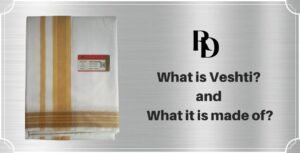Difference Between Dhoti and Lungi
In a world driven by fashion trends and fusion wear, traditional clothing like the dhoti continues to hold its charm. More than just a garment, the dhoti represents grace, culture, and identity in Indian tradition. While many confuse it with the humble lungi, these two serve different purposes, styles, and sentiments. In this article, we focus on the elegance of the dhoti and how it stands apart from the lungi, not just in appearance but also in meaning.
What is a Dhoti?
A dhoti is a traditional men’s garment, mostly worn in South India, though it’s popular across various regions of India under different names. It’s a rectangular piece of unstitched cloth, typically made of pure cotton, ranging from 4 to 5 meters in length. It is wrapped around the waist and legs, and usually knotted at the waist.
-
Cultural Significance: The dhoti is not just an outfit; it’s considered a symbol of purity and humility, especially in religious or ceremonial settings.
-
Types of Dhotis: You’ll find dhotis in various types: plain white, colored borders (karai dhoti), fancy borders for weddings, and single vs double dhoti formats.
-
Occasions for Wearing Dhoti: It is traditionally worn during weddings, festivals, temple visits, and other formal or religious occasions.
How is Dhoti Different from Lungi?
While both dhoti and lungi are wrap-around garments, they differ vastly in usage, formality, and design. Let’s break down the key differences:
1. Draping Style
A dhoti is tied securely at the waist with pleats and sometimes tucked between the legs for added mobility. It requires proper folding and draping, giving it a formal and traditional look.
A lungi is is usually stitched into a tube shape and wrapped around the waist without any pleats or knots. It’s quick to wear, often folded upward for ease during daily activities, making it more suitable for casual or home use.
2. Purpose and Occasion
Dhoti is worn during formal, religious, and cultural events. It’s a mark of respect and tradition.
Lungi is usually worn for casual, everyday home use, especially in humid regions like Tamil Nadu, Kerala, and West Bengal.
3. Fabric & Finish
Dhotis are made with fine cotton, often starched for crispness. They may feature elegant borders (karai).
Lungis are made of softer, loosely woven cotton, often with checks or printed patterns.
4. Size and Length
Dhoti is longer, covering up to the ankles or folded to the knees.
Lungi is shorter, usually falling below the knee or mid-calf.
5. Regional Preference
Dhoti is more prevalent in ceremonial South India, like Tamil Nadu and Andhra Pradesh.
Lungi is common in daily wear across Kerala, Tamil Nadu, West Bengal, and Bangladesh.
6. Symbolic Value
Wearing a dhoti is often associated with respect, spirituality, and cultural identity.
Lungi, while practical, carries no ceremonial or spiritual significance.
Common Misconceptions About Dhoti and Lungi
A dhoti is a traditional men’s garment, mostly worn in South India, though it’s popular across various regions of India under different names. It’s a rectangular piece of unstitched cloth, typically made of pure cotton, ranging from 4 to 5 meters in length. It is wrapped around the waist and legs, and usually knotted at the waist.
Many people—especially from urban or non-Indian backgrounds—tend to mix up dhotis and lungis. Here are some common myths:
- Myth: Dhoti and lungi are just two names for the same garment.
- Truth: They differ in purpose, material, and social context.
- Myth: Only older men wear dhotis.
- Truth: Many young men now wear stylish dhotis at weddings, temple visits, and even cultural events.
- Myth: Lungis are more comfortable than dhotis.
- Truth: Lungis are convenient, but a well-tied dhoti can be equally comfortable and more presentable.
Why Dhoti Is Preferred for Special Occasions
-
Visual Elegance: The crisp, clean look of a white or silk dhoti with a golden border elevates your entire outfit.
-
Cultural Symbolism: Wearing a dhoti shows respect for tradition, elders, and sacred ceremonies.
-
Versatility: Pair it with a shirt, kurta, or angavastram. It adapts to various formal styles.
-
Social Prestige: In many communities, the dhoti is considered a status symbol during events.
Whether it’s a Tamil groom in a double dhoti or a classical dancer performing in a neatly folded dhoti, the garment has a lasting cultural impression.
Choosing Between Lungi and Dhoti: Which One’s Right for You?
| Feature | Dhoti | Lungi |
|---|---|---|
| Use | Ceremonial & Formal | Casual & Home Wear |
| Fabric | Crisp Cotton/Silk | Soft Cotton/Blends |
| Draping | Pleated, Tied | Slipped On |
| Design | Plain, Karai, Fancy Borders | Checked, Printed, Box, & etc.. |
| Cultural Value | High | Low |
Final Thoughts
The dhoti is not just a piece of cloth; it’s a cultural identity, a sign of respect, and an elegant alternative to western formalwear. While the lungi has its own space in daily comfort wear, the dhoti’s charm lies in its traditional richness and dignity.
So next time you’re getting ready for a wedding or a festive occasion, don’t hesitate—tie that dhoti with pride.
Explore premium quality Rhythm Dhotis and embrace tradition with style.










